I've had such great success with my baker's cyst! It's really given me noticeable improvements. I'm very happy with the products, so now I've ordered the Back BFST.
Connie from New JerseyColdCure Leg | BFST hip | Pre-Cut TapeJuly 15, 2022


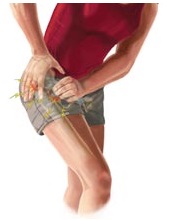
Hip Bursitis is a term that is used to describe a build up of fluid in the side of the hip. Typically, people notice pain and a lump in the side of their hip. For some people, the lump isn't noticeable, just the pain. Others notice more lump and little pain. Both situations are often Hip Bursitis.
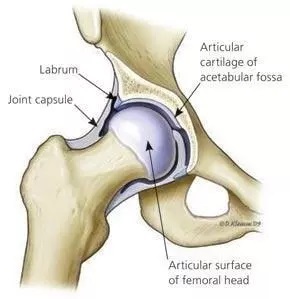
A Bursa is a little sac in your body that works with a 'synovial membrane' to protect your joints.
The spot where two bones meet at a joint can be a very harsh environment. When two bones meet in a joint, they don't actually come in contact with each other as 'bone on bone'. Rather, at the points where one bone would 'touch' the other, your body actually grows cartilage on the end of each bone. The cartilage acts as a bumper, and a wear pad, and slippery surface so the bones don't wear on each other. Cartilage is designed to take the abuse when two bones touch. Over time, if it gets damaged, it repairs itself. The process is slow, but that's what it is designed to do.
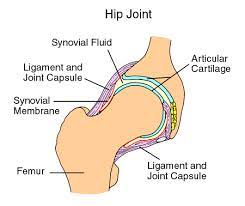
To provide even more protection, your body seals off the inner area of most joints with something called a synovial membrane. Then it fills the membrane full and tight with synovial fluid which acts as a lubricant. Synovial fluid also acts as the blood in your joint, nourishing and cleaning the area, because that environment is too harsh for normal blood to do the job. The synovial membrane is so packed with fluid, that it also acts like a little, flat, water balloon, keeping the ends of the bones and cartilage from touching... most of the time. That water balloon barrier actually prevents the cartilage from rubbing on one another too much. When the cartilage do bump and wear on each other, from time to time, there is no harm done. If the bump or grind is significant, the cartilage may get a bit damaged. Then, the synovial fluid is the lifeblood that helps the cartilage repair itself.
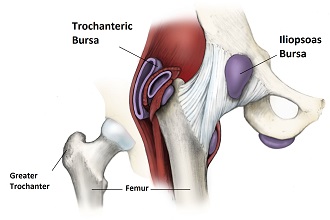
Connected to the synovial membrane, is a sac that swells and shrinks a tiny bit as your joint is compressed and relaxed - That's your bursa. When your joint bones squeeze together a bit of fluid moves into the bursa. When your joints relax, the bursa pushes the fluid back into the joint. That back and forth movement of synovial fluid is the 'blood flow' for your joint and it keeps all the tissue in there healthy. Constant motion is good for your joints. It keeps them healthy. Your joints are designed for constant motion.
Your bursa can take different shapes depending on the joint it's part of. Your body often grows the bursa strategically, so that it acts as another pillow, to stop other tissue in your body from rubbing on each other, like your ligaments and tendons where they run close to the bones. So, a bursa is an important part of your joint health. It's part of the protection, lubrication, nourishment, and cleaning of every joint.
'Bursitis' is what we call it when your bursitis swells up excessively with synovial fluid. When your body detects some sort of issue to the tissue (like the cartilage) in your joint, it starts producing more synovial fluid because it wants to protect and lubricate and nourish and clean the area. That's a good thing! But, when a problem persists in your joint, for weeks or months, your body produces more and more synovial fluid. When too much synovial fluid is produced, the bursa will start to swell. That is Bursitis.
Bursitis is not an injury. Bursitis is the result of your body responding to some other injury that is not in your bursa. Bursitis is a symptom. The injury is in some other part of your joint, most commonly the cartilage.
What is the underlying injury that is causing you to have Hip Bursitis? Most people with a Hip Bursitis don't realize which part of their hip is actually injured. That's why they are looking for information on Hip Bursitis, instead of the real problem in their hip. This is very common.
The most common underlying injury is cartilage damage on one or both bones. Cartilage is very tough tissue. It is a rubbing pad, a protector, between your hip bones so they don't actually rub on each other. You may have heard the term 'bone on bone'. Bone on bone is not a good thing which is why there is always cartilage between bones. Sometimes that cartilage get's a bit of a tear in it. Sometimes it just gets a bit frayed on the outsides. When the tear is significant you feel it in your hip long before Hip Bursitis develops. When the cartilage damage is minor though, you may not feel it. The original injury goes unnoticed. Then, your body produces extra synovial fluid to help do all those good things for your cartilage that we discuss above. If your cartilage heals you never know there was a problem. But if your cartilage doesn't heal (typically because of small repetitive reinjury), your synovial fluid can build up to a point where Hip Bursitis develops.
The next most common cause is Osteoarthritis. People often don't realize there are two kinds of Arthritis: Osteoarthritis and rheumatoid arthritis. Rheumatoid arthritis is the bad one because it's a disease-like condition and it is a problem that doesn't go away. But most arthritis is actually osteoarthritis which is a problem coming from overuse - overactivity in a joint.

We want to be clear here though. Overactivity that causes osteoarthritis is when you do something excessively strenuous over and over. If the activity is light, you can do it endlessly and not have to worry about developing arthritis. If the activity is light, the synovial fluid is always in the middle of the joint, and the joint moves freely and without damage. Walking and jogging on flat land, as well as tread mills, and elliptical trainers, are generally considered light activity.
If the activity is heavy, if you are putting a lot of pressure on the joint during the motion, the bones can push together to the point the synovial fluid gets squeezed out of the way and the cartilage touch each other. Even this can be okay, because the cartilage is there for that purpose, to be a bumper and wear pad during times of heavy strain. But there's a limit.
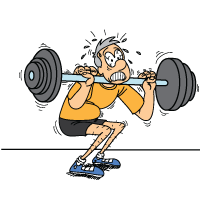
If you do a heavy load activity over and over and over again so that the cartilage is constantly bumping and grinding on each other, then it is possible they get worn down over time faster than they can regenerate. When that is the case, a doctor will tell you the joint has developed osteoarthritis.
Osteoarthritis can go away if you let up on the activity and let the joint heal. Often, active people develop osteoarthritis in their joints that they don't even realize is there. And the body's response to osteoarthritis is, again, to start producing synovial fluid to help the joint heal. When it is mild enough that you don't notice it, but it persists for a long time, then that can cause Hip Bursitis to develop.
Again, it's worth noting that if you are doing mild repetitive activity, you are not likely to sustain any injury no matter how much you do it. If the cartilage on the bones is not being pushed hard enough to bump and rub a lot, then your joint can do that activity forever. So don't get confused by the terms 'overuse injury' and 'repetitive strain injury'. That sort of injury only occurs if the excessive activity is also excessively strenuous on the joint.
There are other much less common hip injuries that can result in Bursitis. Suffice it to say that if some part of that hip has an injury that you don't know about and your body is trying to resolve it for a long time, Hip Bursitis can result.

Your hip is designed to be in constant motion. That motion contributes to circulation and prevents the parts of your joints from getting squeezed for too long. People don't realize, you can actually hurt your hip by 'doing nothing'. Constant pressure on a body part when it is not moving can lead to injuries called Isometric Strain Injury. If you are inactive for an extended period of time, and your hip is being held in a position where part of it is being squeezed to much and too long, you may be hurting yourself.
You have a synovial fluid buffer between the bones in your hip and cartilage on their ends to protect them when they get too close. When you move, the fluid is squeezed from between the bones into the bursa and back when the squeeze is released, over and over again. It's designed to work that way.
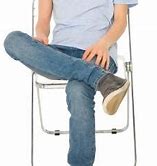
It's possible, though, when you stop in the wrong position, that your bones squeeze the joint constantly. When that happens, the synovial fluid can get all squeezed away until the cartilage from one bone is pressing constantly and firmly on the other. If you stay like that long enough you can do some damage to your cartilage. Or, if you move the joint, while the cartilage are tightly squeezed together, they may tear. If that position is held for really long periods of time, day after day, that damage may accumulate.
The same goes for your tendons and ligaments and nerves and the other tissue in your hips. If they get squeezed under a lot of pressure for a very long time, they can get damaged. Very often, it is the times when we're not using our bodies that cause the condition. And that kind of damage doesn't hurt when it's happening. It hurts later, when you try to use the tissue for your normal activity. Very often, that is what is behind Hip Bursitis, especially when you don't remember an event that could have caused it in the first place.

So, the chances are high that you may be hurting your hips during times of inactivity. It may be when you are sitting for long periods with your legs crossed. Or you may stand for hours with your hip extended and all your weight on one leg. It may even be a position that you sleep in for long periods. There may be times when your hip is locked in one position for a long time and with a fair bit of weight or pressure. Think about it.
With Isometric Strain, you probably don't notice it when you're actually doing the damage. This makes it hard to figure out because you end up feeling the pain during other times of activity. It is quite possible that the activity you are doing when you feel the pain isn't the root cause of the problem. But the pain is an indication that your situation is bad enough that your activity may start to make your situation worse. The good news is that if you correct the underlying cause and treat the condition so it heals, you may be able to resume your favorite activity and never have to worry about hip bursitis again.
So often people go to their GP complaining about pain and swelling in the hip and the doctor says, "it's hip bursitis". In the vast majority of cases, that is likely to be an incorrect diagnosis.
There are many hip issues that can show up as pain and swelling. There could be ligament damage or a torn tendon, or perhaps tendonitis. There could be bone spurs. You might have rheumatoid arthritis or be feeling osteoarthritis without bursitis being part of it. It may be something more serious. Whatever the case, declaring it 'hip bursitis' is just the doctor saying you have a symptom.
You want to know the underlying cause so you can address the issue most effectively. An X-Ray or an MRI will provide further insight, so the real issue can be properly diagnosed. If you know what part of your body is injured and in what way, it will give you valuable insight into what you can do to recover properly and completely.
Hip Bursitis is going to last until your body successfully heals the underlying injury. By the time that swelling develops to the point that you notice it, you have probably had the injury for several months already. There's no doubt about it, something in your lifestyle is causing your injury to persist - your body can't heal the problem as fast as its getting reinjured. So, it is unlikely that it will just go away, unless you change something about your activity.
Some people get to this point and realize what may be the root cause. Perhaps it was an increase in activity level or a new activity. Perhaps it was that you have always maintained a fairly high activity level, but as you age or gain weight (we almost all do a bit with age), maybe your body can't keep up as well. In many, many cases, you did something once that caused you to have an injury in the moment, and it didn't have a chance to heal, and the injury has persisted ever since. That's the best scenario, because if that's the case, if you can allow your body to heal and get past that injury, you are likely to be able to return to the same activity level as before and never have the problem again. No matter what the cause, though, you have an underlying injury and you need to let it heal. If you heal your injury, regardless of the reason it started in the first place, your bursitis will go away and you will likely be able to resume normal life. That is, if this whole ordeal is dealt with properly...

The internet is full of bad advice about treating your hip. Here's a short list though: It's not your shoes. Draining it doesn't solve the underlying problem. Anti-inflammatories don't help - it's not that kind of swelling. Pain killers probably make it worse. Driving through the pain will just make it worse.
For a little while - not forever - it is really helpful to give your hip a rest. In many cases, resting your hip for a few weeks will give it time to heal to a point that your body gets ahead of the healing / reinjury cycle. It's important to realize that once the pain and lump go away, your underlying injury may not be healed completely, so take it easy. Go back to regular life gradually, once the pain and swelling are gone. If you want to be more proactive about healing the problem, you can click here to visit the Recommended Treatments page.
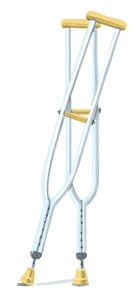
If you want your swollen hip bursa to go away as quickly as possible, you need to rest the affected hip. Avoid any physical activities that could cause further injury to your hip. If your bursitis developed from a hip injury or condition, do your best to avoid the activity that caused this hip injury or condition. Consider using crutches to keep the weight off your injured hip and avoid re-injury.
Do regular ColdCure® treatments to control the pain and swelling. The compression during each treatment helps gently move the synovial fluid back into your hip from the bursa sac.
You can also focus on healing your underlying hip injury with regular BFST® treatments. This combination will work to finally get rid of your swollen bursa.
Around the 4-6 week mark you can start doing some light stretching and strengthening exercises. Slowly work your way back to your regular level of activity. Continue doing BFST® treatments long after the pain and lump disappear to maintain the healing you've done. Do a ColdCure® treatment if you experience any flare-ups of pain and swelling and after any significant activity.

You don't have to undergo surgery in order to get rid of your hip bursitis. You can get rid of your problem with conservative treatments. However, it's possible that your underlying hip condition or injury requires surgery. These are very rare cases.
Hip surgery usually involves the removal of part of the cartilage and that is not what you want. That's a path to an eventual full hip replacement, it's just a temporary fix. You want to do everything you can to let your cartilage heal on its own.
Only in rare cases is it required for the bursa to be drained or removed. If it's an option, you want to keep the synovial fluid and just move it back into your hip joint where it belongs, where it can help. In order to remove a Hip Bursa, arthroscopic surgery must be performed.
If surgery is your only option, make sure your post-surgery recovery goes as smoothly as possible by using BFST and ColdCure. Use a ColdCure® Back and Hip Wrap to reduce the inflammation and relieve the pain for the first few days following surgery. Once the inflammation has gone down, promote blood flow to the injured area using a BFST® Back/Hip Wrap. This will improve your circulation and help you heal faster.
There is also a possibility that the bursa could rupture, causing fluid to move into the surrounding tissue result in further swelling and pain in your hip. A ruptured bursa isn't great, but it's not the worst situation either. Until the underlying injury is dealt with, in some circumstances, it becomes difficult for the ruptured bursa to heal. You want a functional bursa to keep capturing the synovial fluid and return it back into your hip. Symptoms of a ruptured bursa are similar to those of a blood clot, so if you're not certain that your bursa has ruptured, please see your doctor.
Painkillers mask the pain, causing you to continue to stress and injure your hip. This will only make your condition worse. It is understandable that people need relief from the pain, so if you have to take painkillers, restrict them to times when you are off your feet. You can use painkillers to help you sleep. Using them when you are active is a recipe for permanent damage. Your choice of pain killers is important. You can give us a call to discuss which ones are best.
The ColdCure® Back and Hip Wrap is designed to relieve the pain associated with hip bursitis. This safe and effective pain reliever is also great at bringing down swelling and inflammation. The ColdCure® Back and Hip Wrap is incredibly soothing and provides support and protection for your hip. The painkilling element is incredibly powerful and it works instantly - there's no 20 minute wait like with pills.

Hip Bursitis can be extremely painful and debilitating. Painkillers such as ASA or acetaminophen are often used to treat the pain but these drugs do nothing to treat the actual condition. In fact, most painkillers are also blood thinners and make the bleeding worse for fresh tissue injuries. Cortisone injections are used in extreme cases but these too are intended to address the pain. They do not promote healing of the injury itself and they put you at a very high risk of further injury.
You don't have to wait for endless months in pain. You can heal much more quickly with the right treatment. For a hip injury, blood flow is the most critical element in rapid recovery. Blood Flow Stimulation Therapy™ (BFST®) gives your hip the blood flow it needs to heal quickly and completely.
BFST® brings extra oxygen and nutrient-rich blood to the injured area - a requirement for the body to heal itself. Unfortunately, an injured hip at rest often has restricted blood flow, which extends your healing time and greatly increases the amount of scar tissue that develops. With a King Brand® BFST® hip Wrap, blood flow can be stimulated in the area of injury while you are at rest. With improved blood flow and without physical activity and the risk of re-injury, you can recover from your hip injury at a surprisingly rapid rate.
I've had such great success with my baker's cyst! It's really given me noticeable improvements. I'm very happy with the products, so now I've ordered the Back BFST.
Connie from New JerseyColdCure Leg | BFST hip | Pre-Cut TapeJuly 15, 2022

King Brand® soft tissue rehabilitation medical products are the #1 choice by top Athletic Therapists and Medical Practitioners worldwide. We provide guaranteed results and customer satisfaction. Like all King Brand® products, there simply isn't a better performing option. All King Brand® products come with a 100% satisfaction guarantee. Try our products and if you are not completely impressed, you can send them back for a full refund. We know you will love them though, because thousands of people already use them and rave about the results.
Click here to see our Customer Reviews
King Brand® BFST® and ColdCure® Wraps are FDA Registered medical devices. They are intended to prevent, treat and cure soft tissue injuries and chronic conditions. Part of being an FDA Registered company means that our products are made from high quality, biocompatible materials. These devices are manufactured and tested to the highest safety standards in the industry.